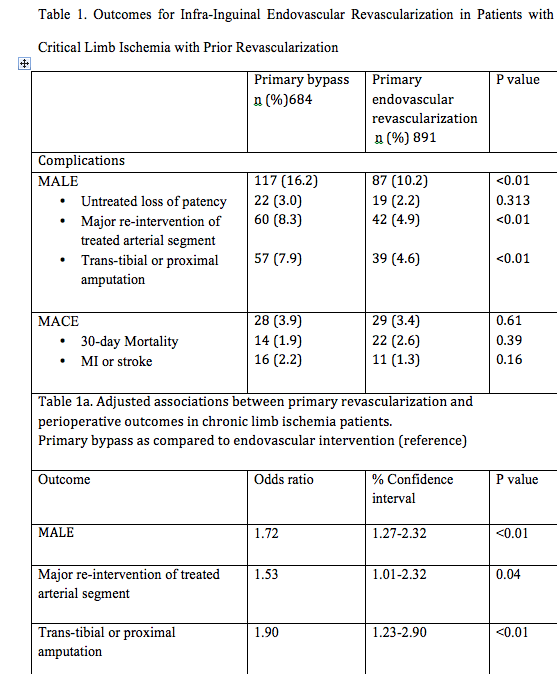Perioperative Outcomes for Infra Inguinal Endovascular Revascularization in Patients with Critical Limb Ischemia with Prior Revascularization
Anand Dayama, MD1, Ying M. Tan, MD1, Stephen Kolakowski, MD1, Misty D. Humphries, MD, FACS2.
1San Joaquin General Hospital, French Camp, CA, USA, 2Surgery - Vascular and Endovascular, UC Davis Medical Center, Sacramento, CA, USA.
Introduction: Patient with critical limb ischemia frequently requires multiple treatments to prevent limb loss. In this study, we sought to evaluate perioperative outcomes of infra-inguinal endovascular revascularization in patients with a history of prior revascularization presenting with critical limb ischemia, and to evaluate the effect of initial revascularization on outcomes of secondary interventions.
Methods: We reviewed the ACS-NSQIP targeted lower extremity revascularization database from 2012 to 2015 to identify patients undergoing endovascular intervention after initial bypass or endovascular intervention for CLI. The primary end point was major adverse limb event (MALE) and major adverse cardiovascular events (MACE); secondary end points were amputation-free survival at 30 days, re-intervention, patency, and mortality. Multivariable logistic regression with effect modification was used to determine the association of initial bypass or endovascular intervention with MALE, amputation and major re-intervention in patients undergoing secondary endovascular revascularization.
Results: We identified 1575 patients undergoing endovascular revascularization for CLI with history of prior revascularization. 684 patients had an initial bypass and 891 patients had an initial endovascular intervention. Patients with initial bypass that required secondary endovascular revascularization had an increased rate of 30-day MALE (16.2% vs. 10.2%; odds ratio [OR], 1.72 [95% confidence interval (CI), 1.27-2.32]; p-value, <0.01), 30-day major re-intervention (8.3% vs. 4.9%; OR, 1.53 [95% CI, 1.01-2.32]; p-value, 0.04) and Trans-tibial or proximal amputation (7.9% vs. 4.6%; OR, 1.90 [95% CI, 1.23-2.90]; p-value, <0.01). Patients with initial bypass also had a higher 30-day reoperation rates (16.2% vs. 13.0%; p-value 0.07) and higher hospital length of stay 6.09±8.54 vs. 4.57±11.89 days; p-value <0.01 compared with patients with initial endovascular intervention.
Conclusions: Critical limb ischemia patients with primary bypass that require endovascular revascularization have significantly higher major adverse limb events and 30-day reoperation rates. These findings have important implications for preoperative risk stratification, patient counseling and informed consent. 
Back to 2018 ePosters




